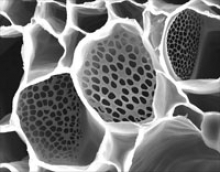You are here
Bullard Spotlight: Michael Knoblauch and Nutrient Transport in Trees

Michael Knoblauch, a plant cell biologist from Washington State University, chose to come to the Harvard Forest as a Bullard Fellow because we had everything he needed to study nutrient transport in trees: "Mature trees of various species, scaffolding and a bucket truck, well-equipped labs, a quiet environment, accommodations - and," Knoblauch adds, "great people."
Knoblauch studies the tree's phloem tissue system, which he compares to the human circulatory and nervous system. Phloem is responsible for nutrient transport and long-distance signaling in plants - an especially impressive system when the height of trees is taken into account. The underlying mechanism driving that long-distance transport is unknown, but was hypothesized more than 80 years ago.
Knoblauch says this transport hypothesis is plausible, but he is the first to actually test it. And it's complicated work. "Phloem is extremely difficult to access," says Knoblauch. The system is fragile, and injury caused by invasive scientific equipment leads to an immediate shutdown of transport.
To protect the intact phloem structure, Knoblauch puts entire plants under the microscope. "In the case of large plants such as trees, that means that we have to get a microscope into the tree's canopy," he says. All summer, he could be found in the treetops at Harvard Forest, perched on scaffolding or a bucket-truck, making meticulous measurements with a microscope and a glass needle thinner than a human hair.
- Read the New York Times feature: Exploring a Tree Once Cell at a Time
- Read the Washington State University feature: On Closer Inspection
- Learn more about the Charles Bullard Fellowship program.
Photo from Froelich et al. 2011. Phloem ultrastructure and pressure flow: SEOR protein agglomerations do not affect translocation. Plant Cell . Plant Cell doi/10.1105/tpc.111.093179. Copyright American Society of Plant Biologists.

